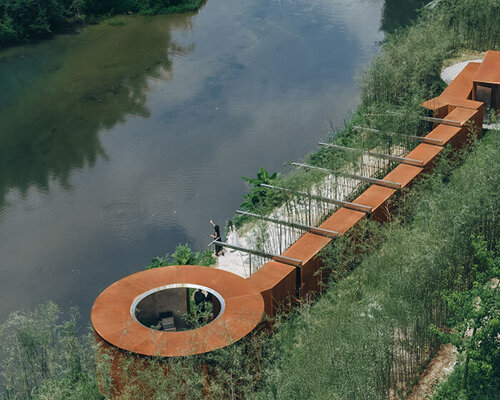Elongated loop pavilion by DL Atelier traces Tiegang River’s flow
Located within a bamboo grove between a road and the Tiegang River in Longtan Town, Huizhou, Guangdong Province, China, the Floral Wander Loop by DL Atelier forms part of the Nankunshan–Luofushan Rim Pioneer Zone Architectural Art Project. The initiative draws inspiration from Su Shi’s ‘Sixteen Joys of Life in Huizhou,’ a literary work composed during the poet’s exile in the region. Each of the sixteen installations along the circuit road interprets one of these joys; the Tiegang River Pavilion, Floral Wander Loop, references the motif ‘Humbly sought to make flowers bloom.’
The project reinterprets this poetic metaphor through spatial experience rather than literal representation. The building is organized as an elongated loop that aligns with both the flow of the river and the movement of vehicles along the adjacent road. The circulation departs and returns along the same route, alternating between constricted and open spaces to generate a rhythmic sequence of compression and release. Within the limited site of the bamboo forest, this continuous path extends the visitors’ journey, transforming movement itself into a spatial narrative. The design mediates between two linear continuities, the road and the river, by establishing a third layer within the bamboo grove. The pavilion serves as a spatial interface rather than a barrier, allowing natural drainage and vegetation to remain uninterrupted. The main structure consists of narrow weathering steel modules measuring approximately 2.1 meters high and 1.2 meters wide, arranged in a staggered parallel configuration to form a passageway. The units are elevated slightly above the ground on 1-centimeter steel plates, ensuring water permeability and preserving the site’s natural contours.
all images by ©Zhu Yumeng – Coppak Studio
Floral Wander Loop forms a sequence of four spatial narratives
The pavilion unfolds through four spatial episodes, Pleasant, Powerless, Serendipitous, and Expansive, each reflecting a different stage in Su Shi’s life and poetic expression. Pleasant: The entrance plaza follows the site’s natural topography, opening at a higher elevation. Defined by gravel paving, bamboo edges, and minimal seating, it includes facilities such as a water bar and restrooms. This open and calm setting introduces the journey before descending into the narrow metallic passage. Powerless: Within the corridor of weathering steel, visitors encounter a constricted, dimly lit environment. Here, environmental elements, light, wind, and rain, are perceived through narrow apertures, producing a heightened awareness of natural phenomena and spatial tension. Serendipitous: The path concludes in a circular pavilion containing a floral installation by artist Chen Zhuo. Inspired by natural rock formations, the work is rendered in stainless steel with a random hairline finish that diffuses color and light. A central skylight frames the bamboo canopy above, marking a transition from enclosure to openness. Expansive: The loop extends outward toward the river, where swings made of metal mesh are positioned along the water’s edge. The open landscape, natural light, and reflective surfaces provide a contrast to the preceding enclosure. The design thus transitions from compression to release, symbolically and spatially.
Through Floral Wander Loop, Chinese practice DL Atelier integrates literary reference, environmental response, and spatial rhythm into a coherent architectural system. The project translates Su Shi’s reflections on transformation and continuity into built form, using minimal materials and topographical sensitivity. Through its looped circulation, adaptive materiality, and interaction with natural elements, the pavilion establishes a dialogue between historical narrative and contemporary architectural language.
the entrance plaza uses gravel paving, bamboo edges, and minimal seating to create a calm threshold
a circular pavilion at the end contains a floral installation by artist Chen Zhuo
Floral Wander Loop by DL Atelier sits between a road and the Tiegang River in Huizhou, Guangdong Province
the pavilion takes the form of an elongated loop following the flow of both river and road
a series of swings expand along the pavilion’s side and the riverfront
the design creates a rhythmic sequence of compression and release within the bamboo grove
narrow weathering steel modules form a continuous passageway through the grove
each unit, measuring 2.1 by 1.2 meters, is slightly raised on thin steel plates to follow site contours
inside the weathering steel corridor, filtered light and wind shape a tactile experience
a central skylight frames the bamboo canopy above, opening the space to the sky
environmental elements such as rain and sunlight interact with the passage’s narrow apertures and skylight
at the river’s edge, a row of metal-mesh swings marks the final, expansive sequence
project info:
name: Floral Wander Loop
architect: DL Atelier
location: Longtan Town, Huizhou, Guangdong Province, China
photographer: Zhu Yumeng – Coppak Studio | @Yumeng_Zhu_coppakstudio
designboom has received this project from our DIY submissions feature, where we welcome our readers to submit their own work for publication. see more project submissions from our readers here.
edited by: christina vergopoulou | designboom
The post rhythmic steel pavilion by DL atelier weaves through riverfront bamboo grove in china appeared first on designboom | architecture & design magazine.

